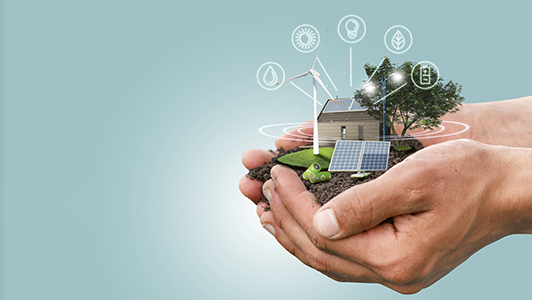The environmental technology market has been experiencing remarkable expansion and advancement, as organizations and governments seek to tackle pressing ecological issues. Environmental technology, also referred to as clean or green technology, belong to the improvement of new technologies focused on tracking, saving, and reducing the harmful effects of technology on the environment and the use of resources.
Moreover, the surge in awareness regarding ecological worries, coupled with fluctuations in climate, the exhaustion of resources, pollution, and the deterioration of habitats, has ended in a sizeable growth in the need for technological advancements that would mitigate these issues. Government rules and global agreements also drive the adoption of environmental technology to satisfy environmental standards and residual emissions targets. For example, in July 2023, the United Nations Environment Program (UNEP) and the Massive Earth Foundation (MEF) teamed up to launch the Low Carbon Earth (LCE) 2023, Climate Technology Accelerator. This program helps startup founders who want to make a difference in fighting climate change and reducing pollution. It gives them a chance to get help, advice, and funding to make their ideas happen.
According to the recent report published by Allied Market Research, the global environmental technology market is predicted to grow at a notable CAGR of 5.1% during the projection period.
Development of environmental technology-
Here, it’s worth mentioning the positive environmental effects of technology resulting from the development of environmental technologies such as renewable energy, smart technology, and electric vehicles.
Renewable energy-
Renewable energy, also called “clean energy”, is derived from naturally restored renewable natural resources such as rain, waves, sunlight, tides, wind, and geothermal heat. Modern environmental technologies have made it possible to collect and convert this naturally occurring energy into electricity or useful heat through devices such as windmills, water turbines, and solar panels.
Smart technology-
Smart home technology uses devices such as connecting sensors and other connected Internet of Things (IoT) devices that can be remotely displayed and programmed to be as energy efficient as possible and meet users’ needs.
The Internet of Things (IoT) is a network of Internet objects capable of collecting and exchanging data through embedded sensor technologies. This information allows network devices to “make decisions” independently based on real-time data. For example, smart lighting systems illuminate only those areas that require it, and a smart thermostat maintains a certain temperature in homes at specific hours of the day, thus reducing waste.
This environmental technology is made possible by increased internet connectivity through the growing availability of smart sensors, Wi-Fi, and Bluetooth in cities and buildings. Experts predict that the cities of the future will be places where every phone, light, air conditioner, car, etc. will be connected, introducing the concept of energy-efficient “smart cities”.
The environmental technology of electric vehicles relies on one or more electric motors and uses energy stored in a rechargeable battery. Over the years, the production of electric vehicles has increased to reduce environmental issues such as air pollution and greenhouse gases.
Electric vehicles-
Electric vehicles exhibit the advantageous influence of technology on the environment, as they do not emit carbon dioxide, which creates a “greenhouse impact” and contributes to global warming. Additionally, they do not contribute to air pollution, which means they are cleaner and much less dangerous to human health, animals, plants, and water sources.
Recently, there have been several government environmental technology incentives promoting plug-in vehicles, subsidies, and tax benefits to encourage the adoption and popularity of electric vehicles.
Electric cars could be the path to a greener society, with companies predicting that electric vehicles could be cheaper than petrol cars by 2024. And according to Nissan, there are actually more electric car charging stations in the UK than petrol stations.
India’s huge environmental technology sector-
The Indian government of trade ministry has identified environmental technology as the “top industrial sector of the future” of the country. India is the world’s largest producer of SO2 emissions and recently adopted policies are driving the growth of the sector. (India released the third edition of India’s Sustainable Development Goals (SDG) Index and Dashboard in June 2021).
Furthermore, India’s environmental technology market is the sixth largest in the world and is ninth in air pollution control and second in wastewater/water supply in the sub-sector world rankings. (Approximately 40% of industrial water and 63% of domestic sewage is discharged, and unprocessed into nearby lakes and river streams).
On the other hand, India’s water demand is expected to double by 2030. (The coastal states of Gujarat and Tamil Nadu are at the forefront of bringing consuming water desalination technology) India’s Ministry of Water Resources has released a national program to provide drinking water to 146 million households in 700,000 villages by 2024. Allocated $51 billion to increase household water coverage from 18.3% in 2019 to 100% by 2024.
In summary, the global environmental technology market is rapidly growing, offering tremendous opportunities for innovation and growth. Moreover, with the emphasis on sustainability, this market will undoubtedly remain a focus for investment and development.
Author’s Bio: Harshada Dive is a computer engineer by qualification. She has worked as a customer service associate for several years. As an Associate Content Writer, she loves to experiment with trending topics and develop her unique writing skills. When Harshada’s not writing, she likes gardening and listening to motivational podcasts.












